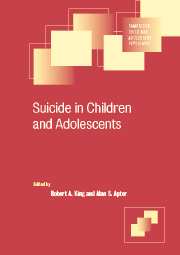Book contents
- Frontmatter
- Contents
- List of contributors
- Preface
- 1 The epidemiology of youth suicide
- 2 Suicide and the “continuum of adolescent self-destructiveness”: is there a connection?
- 3 Adolescent attempted suicide
- 4 Familial factors in adolescent suicidal behavior
- 5 Biological factors influencing suicidal behavior in adolescents
- 6 Psychodynamic approaches to youth suicide
- 7 Cross-cultural variation in child and adolescent suicide
- 8 An idiographic approach to understanding suicide in the young
- 9 Assessing suicidal behavior in children and adolescents
- 10 Suicide prevention for adolescents
- 11 Cognitive behavioral therapy after deliberate self-harm in adolescence
- 12 Follow-up studies of child and adolescent suicide attempters
- 13 Children and adolescents bereaved by a suicidal death: implications for psychosocial outcomes and interventions
- Index
- References
13 - Children and adolescents bereaved by a suicidal death: implications for psychosocial outcomes and interventions
Published online by Cambridge University Press: 04 December 2009
- Frontmatter
- Contents
- List of contributors
- Preface
- 1 The epidemiology of youth suicide
- 2 Suicide and the “continuum of adolescent self-destructiveness”: is there a connection?
- 3 Adolescent attempted suicide
- 4 Familial factors in adolescent suicidal behavior
- 5 Biological factors influencing suicidal behavior in adolescents
- 6 Psychodynamic approaches to youth suicide
- 7 Cross-cultural variation in child and adolescent suicide
- 8 An idiographic approach to understanding suicide in the young
- 9 Assessing suicidal behavior in children and adolescents
- 10 Suicide prevention for adolescents
- 11 Cognitive behavioral therapy after deliberate self-harm in adolescence
- 12 Follow-up studies of child and adolescent suicide attempters
- 13 Children and adolescents bereaved by a suicidal death: implications for psychosocial outcomes and interventions
- Index
- References
Summary
Epidemiology of suicide in U.S.
Although the 30 575 Americans who committed suicide in 1998 did not represent a substantial change in the total number of annual deaths, the suicide rate among adolescents aged 15–19 years old in the United States increased 11% from 1980–1997, while the rate among youngsters 10%–14 years old increased over the same period by 109% (Centers for Disease Control, 2002). “The increased suicide rates are thought to reflect changes in the social environment, changing attitudes toward suicide and increasing availability of the means to commit suicide”, (Kaplan, et al., 1994, p. 1121). Of the nearly 5000 individuals under age 25 years who killed themselves, a large proportion left siblings behind. Furthermore, of the roughly 13 000 people in the 25- to 44-years-old age group who committed suicide in 1998, probably at least half were parents and of the 6000 people 65 years old or older many were grandparents. Thus, it is likely that over 12 000 children and adolescents yearly are affected by suicidal deaths of close family members. This chapter will focus on the psychosocial impact of a family suicide on children and adolescents and discuss intervention strategies at the individual, family, and community level. It will also discuss how these effects may elevate the risk for suicidal behavior of children and adolescents.
An urgent clinical research imperative is to identify factors that elevate or diminish the risk of detrimental outcome for children and adolescents bereaved by the suicide of a relative.
Keywords
- Type
- Chapter
- Information
- Suicide in Children and Adolescents , pp. 294 - 312Publisher: Cambridge University PressPrint publication year: 2003
References
- 2
- Cited by

